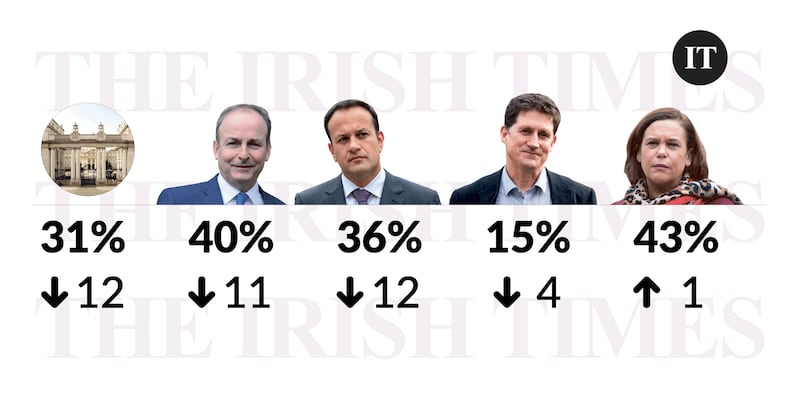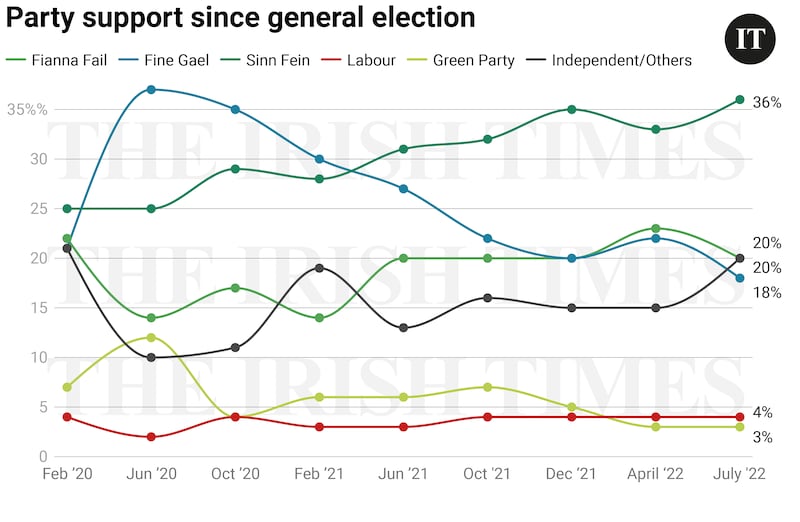Shaping today’s Ipsos/Irish Times poll findings is the cost-of-living surge and an electorate frustrated with the Government’s response to what is for most voters a sudden and sharp decline in their standard of living. Satisfaction with how the Government is running the country has collapsed, down 12 points to 31 per cent.
Public concern regarding the Government’s performance stands in contrast with the sentiment expressed by the Dáil on Tuesday when the Government comfortably won the confidence motion it tabled.
Support has dropped for both Fianna Fáil (down three points to 20 per cent) and Fine Gael (down four points to 18 per cent). The Green Party is unchanged on 3 per cent. Combined support for the three parties of Government – 41 per cent – is at its lowest since the 2020 election.
[ Coalition support slumps in Irish Times poll as cost of living bitesOpens in new window ]
Frustration with the Government is translating into more votes for Opposition parties and Independent candidates.
Actor Armie Hammer resurfaces as host of celebrity podcast
Heart-stopping Halloween terror: 13 of cinema’s greatest jump scares
Doctor Odyssey’s core message: just imagine Pacey from Dawson’s Creek holding you tight and saying, ‘Shhh, it’s okay’
Conor Niland’s The Racket nominated for William Hill Sports Book of the Year
Once again Sinn Féin has lifted its vote ceiling, reaching a new high of 36 per cent, up three points since April. The Independents and Others grouping, comprising smaller parties and Independent candidates, is up significantly, gaining five points to 20 per cent. Looking within this group, Social Democrats are on 2 per cent (no change) and Solidarity/PBP are up one point, to 2 per cent. Aontú registers 1 per cent in this latest poll.
Labour remains on 4 per cent.

Interviewing for today’s poll took place between Sunday and Tuesday of this week. Interviewing was conducted in-home, among a representative sample of 1,200 eligible voters across every constituency in Ireland.
Today’s poll contains many firsts, each of which is illustrative of the how Irish politics has undergone massive change and how sky-high inflation is further accelerating these shifts.
Sinn Féin has set another all-time high, reaching 36 per cent among the total voter population. It is also at record highs among older voters (33 per cent among 35+ year olds), working-class voters (46 per cent), female voters (37 per cent) and rural voters (38 per cent).
[ Analysis: Irish Times opinion poll results signal difficult autumn for CoalitionOpens in new window ]
Over time, Sinn Féin has successfully broadened its appeal, attracting not just older, female and rural voters to its cause, but more affluent voters also. Remarkably, among Ireland’s middle classes, the ABC1s, Sinn Féin (on 26 per cent) outpolls both Fine Gael (on 23 per cent) and Fianna Fáil (on 20 per cent).
Mary Lou McDonald is now the most popular leader in Ireland, with a 43 per cent satisfaction rating.
In four out of the last five Ipsos/Irish Times polls, Fianna Fáil has landed on 20 per cent, so today’s result (20 per cent, down three points) is best described as a reversion to the mean.
To break out of its current range, Fianna Fáil would have to attract more younger/early family life-stage voters, with just 14 per cent of voters aged under 49 aligning themselves with the party.
Micheál Martin’s satisfaction rating has slumped to 40 per cent, down 11 points since April.
Fine Gael’s poll rating of 18 per cent is the party’s lowest in more than two decades. Support for the party ranges from 11 per cent among C2DEs and 12 per cent among 25 to 34 year olds, to 23 per cent among the over-65s and 28 per cent among those from farming backgrounds.
Satisfaction with Leo Varadkar had dropped dramatically, down 12 points to 36 per cent. The pandemic bounce he enjoyed (peaking at 75 per cent) is now eaten bread, soon forgotten.
The Labour Party, on 4 per cent, has not capitalised on the current squeeze in living standards. Working-class voters leaving Fianna Fáil and Fine Gael have gone to Sinn Féin, smaller parties and to Independent candidates. Labour remains a party with a middle-class leaning (5 per cent support among ABC1s and 2 per cent among C2DEs).
There has been no movement in support for the Green Party, nationally (on 3 per cent) or in Dublin (on 5 per cent) despite the announcement by party leader Eamon Ryan that a significant infrastructural investment in public transport for the Dublin area – MetroLink – will go ahead. Satisfaction with the Green Party leader has sunk to 15 per cent, a drop of four points.
As has been shown in previous polls, a loss of confidence in the Government can prove to be a boon to Independents and smaller parties. This latest poll sees the Independents/Others grouping climb five points to 20 per cent, their highest rating since before the 2020 election.

Today’s poll reveals many new highs and lows, but perhaps the most significant is the continued drift to the left against the background of tremendous economic success. For example, never before has support for Fianna Fáil and Fine Gael combined been so low. And never before has support for Sinn Féin and Independents/Others been so high.
If the old adage “it’s the economy, stupid” applied, the current Government would be riding high in the polls. Each week seems to bring news of additional billions in revenue and billions in spending. But public support for the Government is weaker than ever.
Feedback from Ipsos interviewers, anecdotally, is that voters are preoccupied with the cost of living and housing. Ireland’s billions seem unable to solve these problems, leaving voters understandably perplexed and looking elsewhere for answers.
Damian Loscher is managing director of Ipsos





